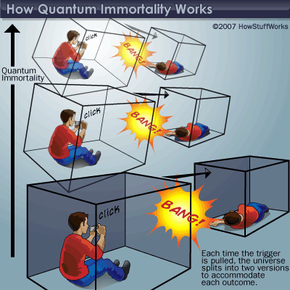A man sits down before a gun, which is pointed at his head. This is no ordinary gun; it's rigged to a machine that measures the spin of a quantum particle. Each time the trigger is pulled, the spin of the quantum particle -- or quark -- is measured. Depending on the measurement, the gun will either fire, or it won't. If the quantum particle is measured as spinning in a clockwise motion, the gun will fire. If the quark is spinning counterclockwise, the gun won't go off. There'll only be a click.
Nervously, the man takes a breath and pulls the trigger. The gun clicks. He pulls the trigger again. Click. And again: click. The man will continue to pull the trigger again and again with the same result: The gun won't fire. Although it's functioning properly and loaded with bullets, no matter how many times he pulls the trigger, the gun will never fire. He'll continue this process for eternity, becoming immortal.
Advertisement
Go back in time to the beginning of the experiment. The man pulls the trigger for the very first time, and the quark is now measured as spinning clockwise. The gun fires. The man is dead.
But, wait. The man already pulled the trigger the first time -- and an infinite amount of times following that -- and we already know the gun didn't fire. How can the man be dead? The man is unaware, but he's both alive and dead. Each time he pulls the trigger, the universe is split in two. It will continue to split, again and again, each time the trigger is pulled [source: Tegmark].
This thought experiment is called quantum suicide. It was first posed by then-Princeton University theorist Max Tegmark in 1997 (now on faculty at MIT). A thought experiment is an experiment that takes place only in the mind. The quantum level is the smallest level of matter we've detected so far in the universe. Matter at this level is infinitesimal, and it's virtually impossible for scientists to research it in a practical manner using traditional methods of scientific inquiry.



